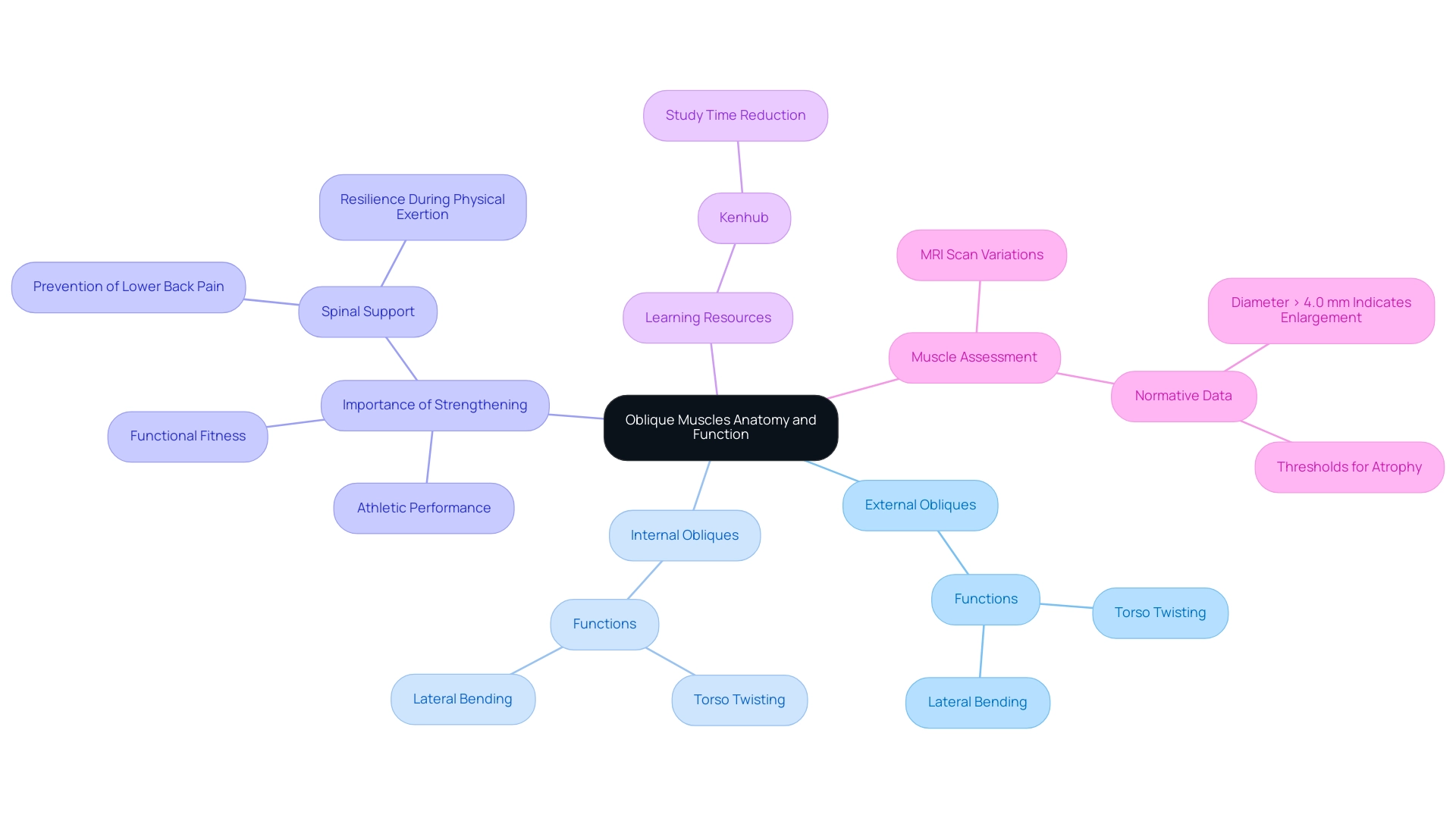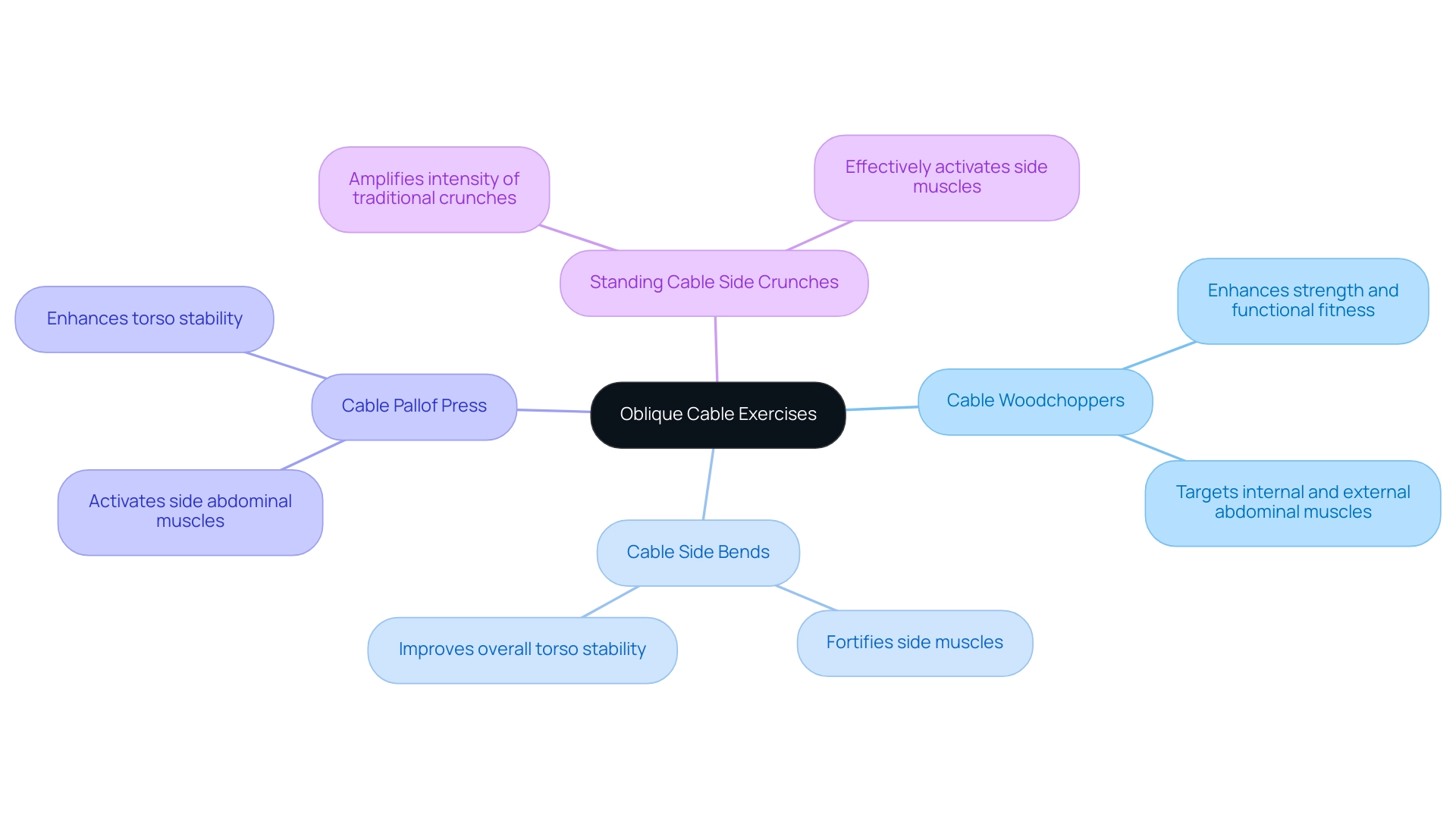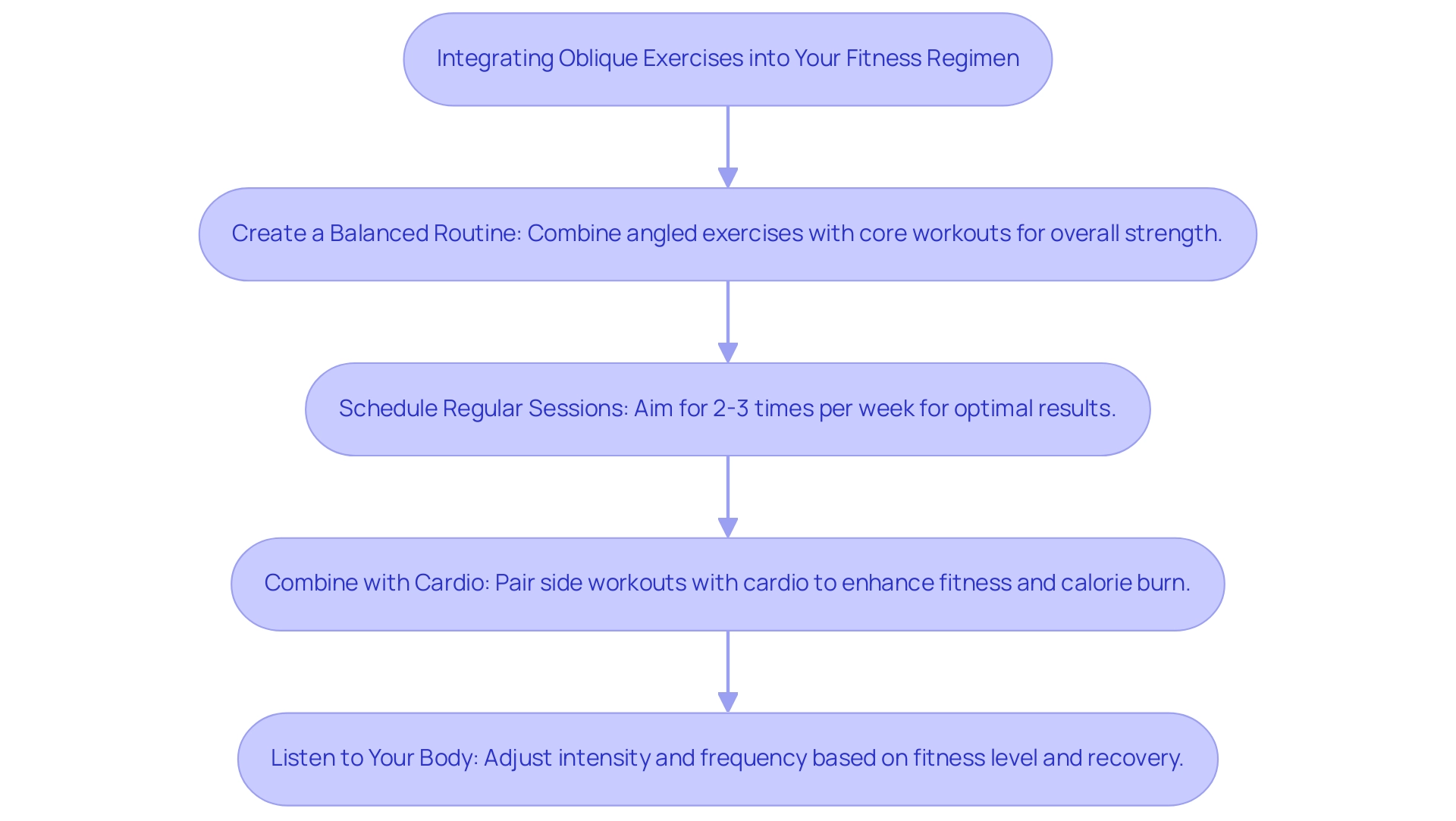Overview
The article provides a comprehensive guide on mastering oblique cable exercises, emphasizing their importance for core strength and athletic performance. It supports this by detailing the anatomy and function of oblique muscles, presenting effective exercises with step-by-step instructions, and highlighting the benefits of integrating these workouts into a fitness regimen, thus demonstrating their role in enhancing stability and reducing injury risk.
Introduction
The oblique muscles, often overlooked in traditional fitness regimens, play a pivotal role in achieving core strength and stability. Located on either side of the abdomen, these muscles are essential for facilitating movements that involve twisting and bending, which are common in various athletic activities.
Strengthening the obliques not only contributes to a more defined midsection but also enhances overall athletic performance and functional strength. With a growing body of research highlighting the importance of targeted oblique training, it becomes clear that incorporating specific exercises can lead to significant improvements in both athletic capabilities and injury prevention.
This article delves into the anatomy and function of the obliques, presents effective cable exercises, and offers insights into avoiding common mistakes, all aimed at optimizing core training for better performance and resilience.
Understanding the Role of Oblique Muscles in Core Strength
The angled fibers, located on both sides of the abdomen, are essential for preserving core strength and stability. They facilitate rotational movements and lateral flexion, which are integral to various athletic activities, including twisting and bending. Strengthening these groups contributes to a more defined midsection while significantly enhancing overall athletic performance.
Research indicates that effective angled training can lead to improvements in functional strength, allowing for easier and safer execution of everyday movements. A systematic review of eight randomized controlled trials emphasized a substantial effect of foundational training on athletes, supporting the idea that strong oblique cable structures help stabilize the spine, thereby reducing the risk of injury during physical exertion. However, it is important to note the study's limitations, particularly its applicability to trained individuals and the lack of longitudinal intervention to observe thickness changes.
Furthermore, statistics show that the average relative thickness of central tissues was greater when using the hollowing technique compared to the bracing technique. This finding highlights the effectiveness of specific training techniques for oblique cable areas. Additionally, a case study titled 'Core Training and Horizontal Jump Performance' demonstrated a large effect size (ES = 0.84) for abdominal training on horizontal jump performance, suggesting a strong relationship between trunk strength and jumping ability.
As noted by expert Ioannis Tsartsapakis, 'These exercises have been shown to effectively increase the thickness of deep core tissues through activation maneuvers.' This emphasizes the significance of including angled training in fitness routines for athletes seeking to enhance performance and resilience.

Anatomy and Function of the Obliques: What You Need to Know
The slanting muscles comprise two main groups: the external slanting muscles and the internal slanting muscles. The external muscles are situated on the outer side of the abdomen and are essential for facilitating torso twisting and lateral bending. Beneath them, the internal muscles contribute to similar movements.
A thorough understanding of their anatomy and function is vital for performing exercises safely and effectively. Strong oblique cable exercises enhance balance and stability, playing a critical role in athletic performance and daily activities. Recent normative data from a study conducted on an Australian cohort revealed that diameters of these tissues, assessed through fat-suppressed contrast-enhanced MRI, can be significantly larger than those measured with standard T1-weighted MRI.
Notably, a diameter exceeding 4.0 mm suggests enlargement, while specific thresholds for atrophy aid in clinical diagnosis. Furthermore, well-developed side muscles provide essential support to the spine, helping to prevent lower back pain and ensuring greater resilience during physical exertion. In this context, Kim Bengochea from Regis University remarked that effective learning tools, such as Kenhub, can significantly enhance understanding of anatomy, stating,
I would honestly say that Kenhub cut my study time in half.
This highlights the importance of resources that facilitate learning about such critical aspects of fitness. Therefore, prioritizing training with the oblique cable not only fosters athletic prowess but also contributes to overall functional fitness. Additionally, it is important to note that variations in measured diameters can occur based on the MRI scan sequence used, further emphasizing the need for precise assessment methods in understanding anatomy.

Top Science-Based Oblique Cable Exercises for Effective Training
Integrating oblique cable machines into your exercise regimen provides distinct benefits for side muscle training, due to their versatility and capacity to target muscles from multiple angles. Here are some of the most effective science-based cable workouts:
- Cable Woodchoppers: This activity efficiently focuses on both internal and external abdominal muscles through a dynamic rotational movement, enhancing strength and functional fitness.
- Cable Side Bends: Emphasizing lateral flexion, this exercise particularly fortifies the side muscles while improving overall stability of the torso.
- Cable Pallof Press: This activity not only activates the side abdominal muscles, but it also improves stability in the torso, resulting in a dual-benefit workout.
- Standing Cable Side Crunches: By merging traditional crunching motions with resistance, this activity amplifies intensity and effectively activates the side muscles.
A review by McGill and Marshall (2012) emphasized the significance of such activities in stimulating abdominal muscles, noting that participants aged 25.60 ± 3.40 years exhibited considerable muscle activation during specific movements. This highlights the effectiveness of these activities in strength training for the torso. As Christopher Covello, a professional freelancer and published author, emphasizes, his fitness journey began with the recognition of the need for sustainable habits.
By incorporating science-based angled workouts with oblique cable exercises into a routine, individuals can experience significant enhancements in their central strength and stability. These activities are not only effective but also vital for developing a strong and stable foundation, which is crucial for overall athletic performance and daily functional movements. Furthermore, the case study titled 'Comparison of EMG Activity in Different Core Exercises' supports the effectiveness of cable exercises, revealing that certain movements lead to greater muscle activation, thus reinforcing their importance in a comprehensive training program.

Step-by-Step Instructions for Key Oblique Cable Exercises
Cable Woodchoppers
- Begin by attaching a handle to the high pulley of the oblique cable machine.
- Position yourself sideways to the machine, with feet shoulder-width apart to ensure stability.
- Hold the handle with both hands, then draw it down diagonally across your body while twisting your torso, activating your midsection throughout the movement.
- Slowly return to the starting position and repeat for 10-15 reps on each side. Maintaining proper form is crucial; ensure that your movements are controlled to maximize effectiveness and minimize the risk of injury.
Cable Side Bends
- Attach a handle to the low pulley of the oblique cable.
- Stand sideways to the machine, gripping the handle with one hand at your side.
- Bend sideways towards the machine, feeling the stretch in your obliques, then return to the starting position.
- Complete 10-15 reps on each side. Proper alignment is key; avoid leaning too far forward or backward to maintain balance and effectiveness.
Cable Pallof Press
- Set a handle at mid-level on the oblique cable.
- Stand with your side facing the machine, holding the handle close to your chest with both hands.
- Press the handle straight out in front of you, engaging your core and keeping your body stable.
- Return to the starting position and repeat for 10-15 reps. As Nate Silver aptly stated, "The numbers have no way of speaking for themselves. We speak for them. We imbue them with meaning." This reflects the importance of understanding your body mechanics during this exercise, as a clear understanding can lead to more effective workouts and progress tracking.
Standing Cable Oblique Crunches
- Attach a handle to the low pulley of the oblique cable and stand sideways to the machine.
- Grasp the handle with one hand and lift your knee towards your elbow, crunching your obliques as you do so.
- Return to the starting position and repeat for 10-15 reps on each side. Focus on controlled movements to enhance the effectiveness of the crunch while avoiding common mistakes such as using momentum instead of muscle engagement.
Importance of Structured Learning
Just as mastering statistics requires a structured learning path, mastering these exercises involves understanding the fundamentals first. Following a step-by-step method to mastering the proper techniques not only improves your performance but also reduces the risk of injury, ensuring that each activity is executed effectively. Monitoring your progress over time, similar to how one would assess step count interventions, can provide valuable insights into your improvements and help adjust your routine for optimal results.

Avoiding Common Mistakes in Oblique Cable Workouts
Maximizing the effectiveness of workouts involving oblique cable requires awareness of common pitfalls. Here are key mistakes to avoid:
- Using Excessive Weight: Lifting too heavy can compromise form and increase injury risk. Starting workouts with a manageable weight ensures proper technique is maintained throughout the activity.
- Neglecting Central Engagement: Engaging the central area is crucial for enhancing stability and exercise effectiveness. When the core is activated, it not only supports movement but also helps in preventing injuries, as noted in a recent study which emphasized the role of trunk stability. The case study titled 'Comparison of Exercise Positions' demonstrated that maintaining trunk stability is essential for optimal activation of the muscles.
- Rushing Through Reps: Many individuals underestimate the importance of controlled movements. Prioritizing speed over form can lead to inadequate muscle engagement and reduced workout effectiveness. Instead, focus on deliberate, slow movements to fully activate the oblique cable muscles. For high to low cable woodchoppers, it is recommended to perform a lower rep range of roughly 10-15 reps to maximize effectiveness.
- Ignoring Breathing Techniques: Proper breathing is essential for maintaining rhythm and supporting trunk stability. Exhaling during exertion and inhaling during relaxation enables better oxygen flow and enhances performance.
By addressing these common mistakes, you can significantly improve your workout technique and achieve optimal results. For example, fitness experts have noted that individuals who actively engage their center and maintain correct form often report improved activation and overall performance. As Ioannis Tsartsapakis pointed out, "These activities have been demonstrated to effectively enhance the thickness of deep abdominal muscles through activation maneuvers."
Incorporating these principles will not only enhance your workouts but also contribute to long-term fitness success.

Integrating Oblique Exercises into Your Fitness Regimen for Maximum Benefit
To maximize the benefits of your angled training, consider these effective integration strategies:
- Create a Balanced Routine: Combine angled exercises with other core workouts, such as planks and traditional abdominal exercises, to ensure a well-rounded approach to core development. This balance is crucial for overall strength and stability.
- Schedule Regular Sessions: For optimal results, aim to incorporate angled training into your routine at least 2-3 times per week. Research indicates that the mean effect size for medium frequency training is 0.71, while low-frequency training has a mean effect size of 0.70 and high-frequency training is at 0.68. This suggests that consistent engagement can yield significant strength gains when the volume of resistance training is equated.
- Combine with Cardio: Pairing side workouts with cardiovascular training not only enhances overall fitness but also boosts calorie expenditure, contributing to improved body composition. This holistic approach can lead to more effective fitness outcomes.
- Listen to Your Body: Tailor the intensity and frequency of your side workouts according to your fitness level and recovery needs. This adaptive strategy is crucial for preventing injury and encouraging ongoing progress.
Additionally, the approach for assessing internal muscle activity has been validated against muscle thickness estimated by ultrasound imaging, providing a credible foundation for these training recommendations. By thoughtfully integrating exercises using an oblique cable into your fitness regimen, you can enhance core stability, improve athletic performance, and foster overall well-being. As evidenced by individuals like Shahril, who transformed his body in just nine months through a dedicated program, the right approach to oblique training can lead to remarkable results.

Conclusion
Strengthening the oblique muscles is a fundamental aspect of enhancing core strength and athletic performance. As detailed in the article, these muscles play a vital role in facilitating rotational and lateral movements, which are essential for various sports and daily activities. By focusing on targeted oblique training through science-based exercises like:
- Cable woodchoppers
- Side bends
- The Pallof press
individuals can achieve improved muscle activation, stability, and overall functional strength.
Incorporating these exercises into a balanced fitness regimen not only contributes to a more defined midsection but also minimizes the risk of injury. Understanding the anatomy and function of the obliques, along with avoiding common mistakes such as:
- Using excessive weight
- Neglecting core engagement
is crucial for maximizing workout effectiveness.
Ultimately, prioritizing oblique training is not just about aesthetics; it’s about building a resilient core that supports athletic endeavors and everyday movements. By integrating these principles into regular workouts, individuals can experience significant improvements in their performance, stability, and overall fitness, paving the way for long-term success and well-being.
Frequently Asked Questions
What are the functions of the angled fibers in the abdomen?
The angled fibers, located on both sides of the abdomen, are essential for preserving core strength and stability. They facilitate rotational movements and lateral flexion, which are integral to various athletic activities like twisting and bending.
How does strengthening the oblique muscles affect athletic performance?
Strengthening the oblique muscles contributes to a more defined midsection and significantly enhances overall athletic performance, improving functional strength for safer execution of everyday movements.
What does research say about the effectiveness of angled training?
Research indicates that effective angled training can lead to improvements in functional strength. A systematic review of eight randomized controlled trials emphasized the substantial effect of foundational training on athletes, supporting the idea that strong oblique structures help stabilize the spine, reducing the risk of injury during physical exertion.
What are the limitations of the research on angled training?
The limitations include its applicability primarily to trained individuals and the lack of longitudinal intervention to observe changes in muscle thickness.
What is the difference between the hollowing technique and the bracing technique?
Statistics show that the average relative thickness of central tissues is greater when using the hollowing technique compared to the bracing technique, indicating the effectiveness of specific training techniques for the oblique areas.
How does abdominal training impact horizontal jump performance?
A case study titled 'Core Training and Horizontal Jump Performance' demonstrated a large effect size for abdominal training on horizontal jump performance, suggesting a strong relationship between trunk strength and jumping ability.
Why is it important to include angled training in fitness routines?
Including angled training in fitness routines is significant for athletes seeking to enhance performance and resilience, as it effectively increases the thickness of deep core tissues through activation maneuvers.
What are the main groups of slanting muscles in the abdomen?
The slanting muscles comprise two main groups: the external slanting muscles, located on the outer side of the abdomen, and the internal slanting muscles, which contribute to torso twisting and lateral bending.
How do strong oblique muscles benefit everyday activities?
Strong oblique muscles enhance balance and stability, playing a critical role in athletic performance and daily activities, while also providing essential support to the spine to help prevent lower back pain.
What should be considered when assessing the diameter of oblique muscles?
Variations in measured diameters can occur based on the MRI scan sequence used, emphasizing the need for precise assessment methods to understand anatomy accurately.

